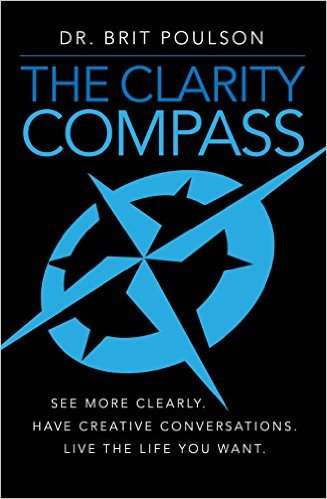The Clarity Compass by Brit Poulson
Most of us are aware that a chasm divides the way we perceive the world from the way it actually is. It’s impossible to see the world perfectly, without distortion. Just think about how much clearer we are today than our ancestors were about certain truths of the physical world. We’re amused, for example, at the fact that not too long ago, most humans believed the Earth was flat. So it shouldn’t be hard to imagine what humans 100 years from now may think about us—how foolish, how naïve they were! (Actually, at the pace we’re moving, those who are 10 to 15 years younger already experience a significant gap in their understanding of the world, compared to their “elders.” Just start talking to them, as I often do, about all this new troublesome technology!). From a historical perspective to modern day, no one can see an objective world perfectly, clearly and accurately.
With the Clarity Compass, we explore the chasm between the world as it is and the world as we perceive it. That gap is created by the number of Blind Spots we have in our Reality Maps.
The first step in transcending our own subjectivity is to focus on what we can actually know: Facts. Facts are those things that can be objectively observed; they cannot be disputed. For example, whatever you see in front of you in this moment can largely be considered as Fact. If there’s a pen in front of you, that’s a Fact. If you watch someone pick up the pen, it’s a Fact that you saw them pick up the pen.
Stories, on the other hand, are things we believe, and for which we have no original, first-hand proof. Beliefs tend to be supported by a few Facts (sometimes very few, sometimes a great many), and the more Facts that support a belief, the more likely it is that that the belief hews close to reality. For example:
Fact: Geneva spilled her coffee on her blouse.
Story: Geneva is careless; or, the spill was bound to happen since she drank so much coffee; or, she was looking for an excuse to leave the office and acted intentionally.
Whereas, the Intentions to Actions Polarity highlights the flow from being purposeful to leveraged activity, the Facts vs. Stories Polarity highlights the difference between something that is observed and that which is interpreted. So in this chapter, we want to learn how to distinguish between the objective events in our experience and how we subjectively perceive them.
Why is this distinction so important? During my doctoral studies in cognition at Georgia State University, my professor, James Pate, drilled into me the difference between empirical data and theoretical interpretations. Scientists have to know the difference between the data they are observing and the conclusions they are drawing from those observations, right? If they aren’t clear on this, we question the validity of their research, their claims, or their findings.
I invite you to be a scientist of your own life.
Because when we rely so heavily on our Stories, we make mistakes. We lose the ability to interact with the world as it actually is, so we create chaos, cloud our decision-making process, and miss out on important opportunities. If you want better results, you need to have a solid grip on the Facts of a situation, and you need to be aware of where you are making assumptions. Which of your Stories are you erroneously calling Facts?
Buy this Book!
Amazon





